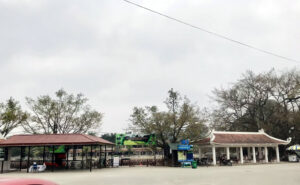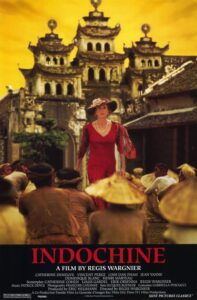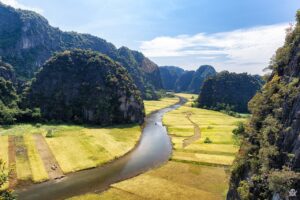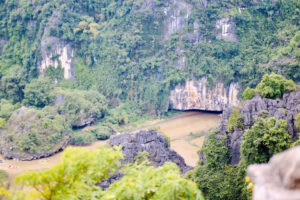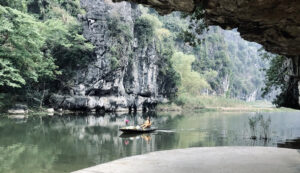Without a doubt, Tam Cốc is the tourist hub of Ninh Binh, Close to most of the main tourist attractions, English skills are high and western type accommodation and restaurants abound. For Ninh Binh residents Van Lam village (the main town of Tam Coc) is often referred to as ”the international village” due to the huge influence international tourism has exerted there.
But it is the hospitality and generosity of the locals that make it special.
In some ways, Tam Coc is still considered ”a hidden green gem”, often overlooked in the mad rush to the major Vietnamese drawcards of Hanoi, Ho Chi Minh City, Ha Long Bay, Hue and Hoi An. However, unlike most places, Tam Coc is not yet overwhelmed with luxury apartments, mega-hotels, nightclubs and mass commercialism. If you want to chill and experience a truly spectacular, eco-friendly and relatively untouched part of rural Vietnam, Tam Coc is calling for you.
International Fame
Tam Coc is part of the UNESCO designated Tràng An Scenic Landscape Complex and is recognized as a World Heritage Site. What many will not know is that It was “discovered” after the movie Indochine won an Oscar in 1993 as some sequences were filmed here. Vietnam was just starting to open up to International tourism at the time and although well known to domestic visitors, rather neglected by overseas visitor. Local residents saw the film as a huge opportunity to promote and expand Tam Coc’s unique features as a worthy destination for even the most jaded of international travelers.
According to Chu Văn Thim, the 90 year old manager of nearby Thái Vi temple, it is believed that million years ago Tam Coc was surrounded by sea with the tops of the now iconic karst mountains small islands breaking the surface. Over hundreds of millennia, the sea gradually receded but left behind an intricate river system that built up a heavy layer of alluvium. When the first human’s arrived some 10,000 years ago the sea had become a lush forest area, so much so that Tam Coc was previously known as ”Vi Vân Sơn” which roughly translated means “a forest as beautiful as floating clouds”.
Those earliest settlers found the forests a rich source of animals and plants to forage. As agriculture developed, the rich land with its deep alluvial plains and an abundance of fresh water sources invited habitation while the Karst mountains themselves, pocked marked with hundreds of caves were a natural protection against the willful climate and wild animals and provided a perfect natural housing.
Civilisation Arrives
Gradually, thos early cave dwellers grew in number and involved into a strong and dynamic civilization. The entire area became famous as a abundant land much sought after by invaders from southern China and the thriving Khmer civilization to the south west . The earliest legends speak of numerous warlords and clans, of gods and magical events and terrible wars and divine intervention.
These early legends are all oral histories passed down from generation to generation as there was no written language until the Han/Xin Dynasties made the land a vassal state. Much of this early history is in Chinese script as successive Southern Chinese Dynasties invaded and ruled here for 1000 years (approximately 1 to 1000 AD in the Gregorian calendar).
That changed when King Dinh Bo Linh united the warlords and pushed back the newly arisen Song Dynasty. At that turbulent time, China also had massive internal changes and the rebellious vassal state to the far south was the least of their problems. Dinh Bo Linh took advantage of the unrest to proclaim Dai Co Viet as a tribute country of the Song, rather than a vassal state and in doing so, the history of modern Vietnam was born.
King Trần Thái Tông
So it was that Dinh Bo Linh (aka King Đinh Tiên Hoàng) became the first emperor to unify Vietnam, making nearby Hoa Lu the capital of the new nation of Dai Co Viet in 968 AD. Nearby Tam Coc slumbered away as an important farming community supporting the new capitol until the Trần dynasty.
When King Trần Thái Tông (1218-1277) visited here to admire the gorgeous mountain landscapes, he decided it had perfect Feng Shui to settled into his monastic retirement. But those ancient Kings rarely abandoned their former lives and the good King Tran immediately began construction of Vũ Lâm “Palace” as both a residence and a stronghold against the newly emergent Mongol empire.
Under his continued direction, King Trần Thái Tông also encouraged the exiles of the previous war to settle here. These battle weary troops built hamlets and expanded the road system while at the same time constructing temples. Many public buildings were constructed during this time and Van Lam fortifyed against the forays from the armies of Kublai Khan. So much for a quiet retirement!
A Noble Retreat
When peace returned, the stunning scenery of Tam Coc attracted many high officials. Tam Coc rapidly became an important meeting center for foreign dignitaries and formal court presentations but also a perfect place for mandarins and rulers to live while conducting day to day business in nearby Hoa Lu. It also became a center for resisteance against the Mongol Empire (1285), when King Trần Thái Tông’s son and grandson repulsed the Mongol – Yuan invasion using Tam Coc as the strategic center of operations. Interestingly, it played a similar role centuries later during World War 2 and the conflict with Japan.
Tourism
These days most visitors converge on the Tam Coc/Van Lam boating station and the riverine tours through the caves and rice fields of the heavily cultivated countryside. Tam Coc translated means “three caves” and the boat ride/s are an efficient, enjoyable and exciting way of visiting these iconic grottoes. It also provides a unique opportunity to get up close and personal with the lifeblood of the region, the Ngo Dong River. Floating along this majestic waterway gives visitors unparalleled interaction with those famous giant limestone outcrops Northern Vietnam is famous for.
The Three Caves
The three caves that give Tam Coc its name are as follows:
Hang Cả (Fish cave)
At 127m long and nearly 20m broad, Hang Ca is a “wet” cave that has worn its way through a karst outcrop to allow entry to watercraft. It is said that it contains more stalactites and stalagmites than any other cave in the area and is one of the largest and most visited. It is also high enough that even during torrential floods the river never reaches the top and so remains open even when others are closed to boat traffic.
Opposite the cave is a small outcrop called Vườn Am (Garden Island) which Feng Shui ascribes as favorable aspect and which once contained a training temple for monkhood. It was later moved to Thai Vi temple but it is still known as a peaceful spot to fish and write poetry (poetry writing being a revered form of art for the Vietnamese noble class).
Hang Cả (Fish cave) is also a “wet” cave and said to be the longest of the three grottoes as it stretches for over a kilometer. The roof of the cave is festooned with a variety of stalactites with a beauty that has challenged the imagination of visitors for countless centuries. It is located about 1km from Ca cave, is about 60m wide in places and is navigable for most of the year.
Hang Ba (Third Cave)
The third cave and is adjacent to Hai cave. Somewhat smaller and lower than the other two it can be somewhat precarious to boat traffic in times of heavy flooding. Parts of the blockbuster King Kong (2015) were filmed here – especially the part where King Kong jumps down into the water. If you are extremely lucky (or unlucky, depending on your viewpoint) you may encounter the wild cats this area is known for. After passing Ba cave there are several karst mountains and a small “village” of stilt houses, where there are toilets and refreshments for visitors – a good place to rest and review your adventure while still surrounded by the beauty of Tam Coc.
Of note is that most of the boats will be piloted by women who row using their feet rather than their arms. This is fairly common for Tam Coc and one assumes it leaves their hands free for the fishing this area is renowned for. In these modern times, it also gives them the opportunity to display the embroidered wares that they will often offer to their passengers.Or, more likely, scroll through their Facebook pages.
Boating
The boat rides are often interrupted by waterborne “touts” offering drinks and souvenirs, usually at inflated prices. The trip can be hot and tiring, especially during the middle of the day so many will find this a convenient resource. Still others who had the forethought to wear appropriate loose clothing, a hat and bring bottled water, will find it an interuption to their idyllic journey. At the end of the trip, the women pilots will also generally expect a “tip” for their efforts. As tipping is not yet in general practice in Vietnam, we leave it up to you.
In addition to the boat trip to the three caves there are plenty of other attractions such as Bich Dong Pagoda, Thai Vi Temple, Thien Huong Cave, and Linh Coc pagoda. As is often the case, the journey itself will be as important as the destination as you will get to enjoy the stunning scenery and friendly locals as you make your own pace through this very ancient and special part of Vietnam.
Van Lam
Van Lam Village is centered by the wharf area and is the main town of Tam Coc. Offers a variety of international restaurants, souvenir shops, fashion houses and so oo, it is very much geared towards the English speaking crowd and you should not find it difficult to navigate. Just be aware of the various scams and petty theft that occur in any tourist destination the world over. Keep your valuables hidden and secure, don’t flash around money, don’t leave valuable unattended and so on. Vietnamese are generally honest, affable folk but such concentrations of newly arrived visitors with cash to spend will always attract some of the worse elements of any society.
Mornings are a great time for exploring but the locals may be limited in their time to converse. The afternoon is a great time, when the sun is hidden behind the limestone mountains and the lights and lanterns are illuminated and the local populace generally have more leisure to walk, talk and learn about the diverse customs and habits of their visitors. Alternatively, you may come across groups of students who want to get to know you and converse in English with you – an often fun and appreciated form of cultural interaction.
Travel Tips
Tam Coc is only around 7km from Ninh Binh city however there is a “short” way and a long looping journey through Trang An. GRAB, the Vietnamese version of Uber is often the cheapest, easier way to move around, with its fixed pricing and journey tracking- and no, a credit card is not necessary. For independent travelers you may get there by following Google Maps to Van Lam, Ninh Hải commune, Hoa Lư district, Ninh Binh province.
Bus
There are many day tours from Hanoi to Tam Coc. Visitors can also choose a two or three day visit that connects with their journey to other destinations. Getting to Ninh Binh itself is quite simple, with a variety of choices. From Hanoi it will take 2 hours to Ninh Binh city from either the My Đình or Giáp Bát bus stations, the fare is from 80,000-100,000VND. A popular alternative are the many “luxury” vans that carry 6-8 people in plush recliner seats and can often pick you up at your hotel in Hanoi and drop you at your hotel in Tam Coc for between 200-400,000 VND.
Train
Ninh Binh also has a modern railway station (Ga) with several trains each day heading south from Hanoi or North from Hue, Da Nang or Saigon itself. Booking is easy via the official Vietnam Rail site but you will need to pickup (and pay for) tickets at the starting Railway station the day prior to departure. You will need to show your passport and payment is usually only accepted in VND. Be careful about third party sites, especially during peak holiday periods.
Drive
Self-drive, either by motorbike or car is an option but Ninh Binh is a fair distance to and from other torusim “capitols”, often along busy main highways, some of which will not allow motorbike traffic or require a toll and generally not very scenic. Remember to have Google Translate and Maps or their equivilent ready at all times.
Accomodation
There are many hotels, homestays and apartments available at Van Lam or beyond. There will always be something to suit a vistors budget or needs but way too many choices to list here. Online booking companies are the best bet or, if you are fortunate enough, get a local to book for you. Again, Tam Coc is a popular destination and can get very crowded during peak periods. Book ahead.

